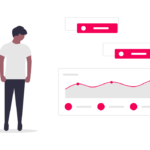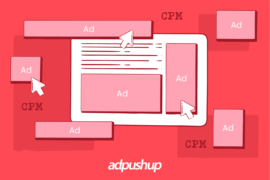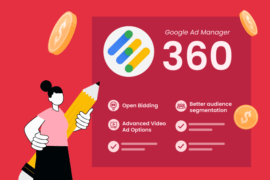As everyone has been raving about Google’s policy of banning third-party cookies, publishers are looking for cookieless options for data collection.
But let’s begin from the beginning.
What are the third-party cookies, what does it mean that Google is planning to ban third-party cookies and why?
However, Google declared that it would stop supporting cookies by 2022, which was delayed till 2023. But what are these cookies, and why do publishers use them?
What are Cookies?
Essentially, cookies are the small pieces of information that publishers collect from the users when they initiate a session on a website. These cookies aid varied functions- ad personalisation, content personalisation, frequency capping, tracking, session management, etc.
For example, the browser saves that website’s cookies upon initiating a session. And when the user visits the website again, the website knows it’s the same user who shows the items based on the user’s past engagement on the website.
What are Third-party cookies?
Cookies are primarily of two types besides session cookies, secure and persistent cookies- First-party and third-party cookies. First-party cookies save the information voluntarily given by the user to the publisher, for example, their username, email address, etc.
Publishers/ Websites set these cookies for calculating page views, number of sessions and users. Websites can share this information with advertisers for ad targeting.
Third-party cookies, however, are set by the websites, not directly visited by the users. When publishers add third-party elements to their websites in social plugins, chatbots, etc., these third-parties track user behaviour on the website for ad targeting.
Why does Google want to ban third-party cookies?
Like Safari and Mozilla, Chrome also plans to ban third-party cookies’ support. For this, Google introduces Privacy Sandbox, whose underlying principle is to masquerade the user data while allowing advertisers to do behavioural targeting without third-party cookies’ involvement. So, where does it leave the independent ad vendors?
Considering the study conducted in 2019, publishers lose about 52% of revenue when users choose to block the cookies; Google brings forth Privacy Sandbox in the light of preserving the privacy of the user data and regulatory scrutiny.
This also means the publishers and the third-party domains are now left hanging dry about how they will do behavioural advertising, user personalisation, and ad targeting.
What is the impact of cookieless data on publishers?
- Publishers cannot use frequency capping on their adverts which will cause their users to look at the same ads repeatedly, following an annoying user experience on the website.
- Publishers will be unable to target and retarget audiences in terms of digital advertising and affiliate marketing.
- There’ll be a struggle in assessing ad efficacy. The publishers can see whether their advertising has led or contributed to conversion when users allow cookies. This will not be possible in the cookieless world.
As it is clear from the aforementioned effects, the publishers shall significantly lose ad revenue without the cookies; cookies are responsible for publishers and advertisers devising specific methods for ad personalisation and enhancing user experience.
What makes cookieless data for publishers special?
With the introduction of Privacy Sandbox, many cookieless data collection options are underway to help publishers and advertisers.
Due to the sudden loss of cookies, publishers will require solutions to calculate their user behaviour and target ads accordingly.
Without cookies, publishers can access a wide variety of user data in identity graphs, universal IDs, contextual data, etc.
What types of cookieless data for publishers are available?
Many solutions have entailed Google’s announcement for a cookieless web world, some have fallen head-first, and some can be called the primary types of cookieless data solutions for publishers. Take a look:
- First-party data
- Contextual data
- Identity Graphs
- Universal IDs
- Cohorts/ FLoC
1. First-party Data:
Email addresses, i.e., first-party data, can be one of the most basic types of cookieless data for publishers and advertisers. Users fill in their email addresses in return for a free subscription, guide, coupon, etc.
However, it is debatable how publishers shall provide their consumers with valuable content and target ads according to their web page behaviour simply based on the email address.
Despite it, first-party data is one of the most reliable methods to get a user’s direct attention. The user is voluntarily consenting to provide publishers with their email addresses.
Although, the cons of first-party data are pretty obvious- scalability and privacy concerns.
Pageviews, ad interactions, page clicks, forum posts, etc., are some of the important first-party data collected. Therefore, first-party data can be one of the essential types of cookieless data for publishers.
2. Identity Graphs:
Another solution to cookieless data for publishers can be identity graphs. An identity graph can refer to collecting data on users on several devices. This includes interaction with the physical stores, which means it collects online and offline data. With identity graphs, a global ID matches the user’s profile, which is essential to distinguish a user across several platforms performing different actions from a casual user.
This type of cookieless data collection option can benefit publishers with insights on real-time changes. With this insight, publishers can update their marketing strategy to target and retarget the customer better.
3. Universal IDs:
A growing solution to cookieless data for publishers is universal IDs for saving data. To be used in place of third-party cookies, advertisers, publishers, and ad tech providers use universal IDs to work based on deterministic matching.
Deterministic Matching refers to identifying a user across multiple devices and platforms without duplication with accuracy.
This type of cookieless data benefits publishers by immunising the websites against cookies blocking because publishers shall no longer need to rely on third-party cookies.
Unlike cookies, universal IDs work with no ridges across mobile, desktop, tablet, etc. with nearly a 100% accuracy rate in matching user identities.
Some of the most popular Universal ID solutions are- DigiTrust by IAB, Unified ID by theTradeDesk, Publisher Common ID, and Advertising ID Consortium.
4. Google’s FLoC:
With no option but to improve privacy and look for effective alternatives to pervasive tracking, Google has introduced Federated Learning of Cohorts, commonly known as Cohorts or FLoC.
Amongst all types of cookieless data for publishers, Cohorts enables an agency for advertisers to target ads retaining the user’s anonymity. FLoC groups users of similar interests and behaviour in the form of cohorts.
While cohorts do not refer to a collection of people but a collection of similar browsing behaviour and activities. Google’s FLoC restricts sharing of users’ browsing history. Owing to ever-changing users’ browsing behaviour, cohorts change and update every seven days. Their browser assigns them to a different cluster. The FLoC API is available in Chrome 89 and above.
5. Contextual Data:
One of the types of cookieless data for publishers is Contextual Advertising. It is an important cookieless data collection option because it doesn’t depend upon any kind of cookies.
It makes use of keywords or keyphrases on the webpage, not requiring users’ data. Contextual targeting, as the name may suggest, takes into account the context of the webpage, that is, the content, and displays relevant ads.
Since ads are relevant and related to the web page’s content, they get more viewability. Contextual targeting ads with rich media make more sense because users can relate to them. However, one should not consider using any one of behavioural and contextual targeting because both are important.
Since deprecation of third-party cookies is inevitable, it only makes more sense that publishers opt for this type of cookieless data.
In ending
Types of cookieless data for publishers will ensure the privacy of the users’ data and keep users satisfied with them being in control of their details. After all, users are the only ones that digital advertising thrives on.

Shubham is a digital marketer with rich experience working in the advertisement technology industry. He has vast experience in the programmatic industry, driving business strategy and scaling functions including but not limited to growth and marketing, Operations, process optimization, and Sales.







